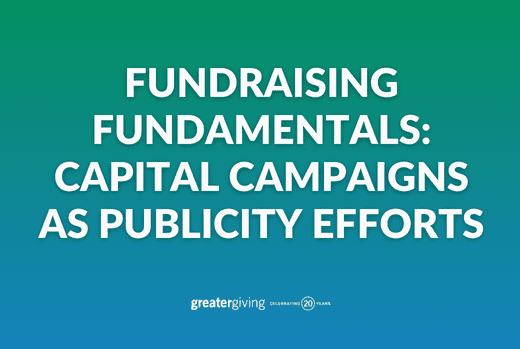
For smaller nonprofits, conducting a capital campaign is a great way to get the word out about your organization.
What is a capital campaign?
Capital campaigns are intended to raise money for a specific project, issue, or program, or to meet an overall, designated fundraising goal.
The capital campaign lasts for a set period of time, and is generally broken up into multiple phases. Phases range from courting big donors in the silent or “quiet” phase, to spreading the net wide in a public phase to include small and individual donors. This second phase, where your nonprofit openly courts all supporters of your cause, also performs as publicity for your organization.
One of the big benefits of a capital campaign is that they are held in addition to regular giving. It’s expected that donors who contribute to the campaign are doing so as a campaign-focused gift, on top of scheduled monthly or annual gifts.
Focus Your Capital Campaign
Focusing your capital campaign on one issue area or specific endeavor (such as building new construction, completing an ongoing project, or funding a popular program) is a great way to draw attention to your nonprofit’s work, and illustrates the steps needed to further the cause. Whatever campaign initiative you choose, it should showcase your mission and demonstrate why you are the best organization to pursue it.
Choose a goal or initiative that clearly illustrates how you plan to address a need within the community, as it can also act a proof-of-concept for future giving.
The Stages of Capital Campaigns
Traditionally, the capital campaign has two distinct phases:
- A silent phase (or “quiet” phase), where nonprofits court major donors directly for funding
- A public phase, when nonprofits solicit widely for additional donations from a variety of sources
What is the silent or “quiet” phase of a capital campaign?
During this phase, nonprofits approach potential major donors individually about the project, positioning the prospective donation as a critical step of the campaign toward meeting your goal. It’s always best to come prepared with an ask—how much money you’re looking for—and what that amount of money will tangibly achieve toward completion of the project.
What is the public phase of a capital campaign?
During the public phase, nonprofits spread the net more widely for prospective supporters, and begin to advertise the campaign to individual donors and the public at large.
What’s the benefit of doing the public phase after the silent phase? Getting initial donations from major donors in the silent phase demonstrates that your nonprofit can foreseeably achieve the fundraising goal. For example, if you have a fundraising goal of $50,000, and manage to raise $20,000 in your silent phase, the final fundraising goal feels achievable and can encourage public donors to chip in and help meet the goal.
The Power of the Public Phase
This public phase of your capital campaign provides the opportunity to drum up publicity beyond this specific project and fundraising goal, potentially generating interest in your nonprofit and the work you do on a day-to-day basis.
When marketing your capital campaign to the broader public, you should have these talking points prepared:
- What is this project about? What need in the community is being addressed?
- How does this initiative fit into your overall mission and help to accomplish it?
- What other similar projects has your nonprofit completed to give donors confidence?
These questions do double duty by informing potential donors of your nonprofit’s overall mission, and demonstrating that you know how to execute it through achievable goals. Show off completed projects like this one, and include measurable results when possible!
Expressing Urgency
One of the big benefits to utilizing a capital campaign over a standard fundraising campaign or initiative is the limited time frame. Setting a specific end date on your campaign places emphasis on giving a gift now, and encourages donors to give before the deadline to achieve the goal.
Capital campaigns generally last 1-2 years but they typically have both a public and internal phase. In the internal phase, the organization may already have committed donors or the funds may be approved through a board vote. Some organizations are either granted or pledge half of the funds prior to launching their capital campaign. The remaining balance is raised throughout the public phase. Make sure to choose a deadline that’s reasonable, but not so far out that it counteracts the urgency of your ask.
Managing Your Public Relations
While it’s a great way to increase fundraising efforts, capital campaigns also play themselves out well as publicity initiatives. Not only can you spread the word about your campaign and organization, but you also have specific goals to be met by a certain time. This helps to keep your donors engaged throughout the process and shows that their money will be put to good use.
